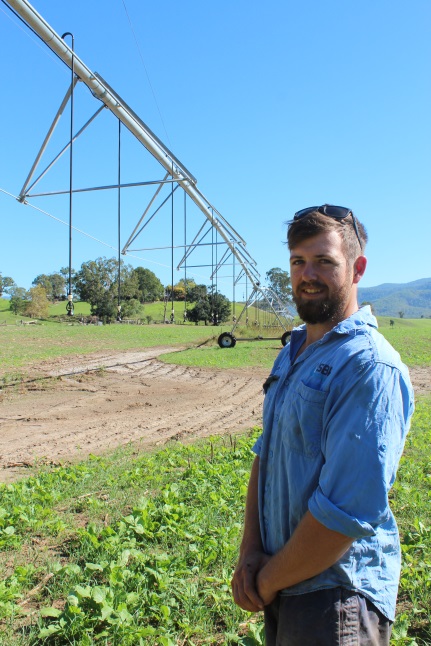Hunter Smarter Farming: Irrigating for Profit
The Hunter Smarter Farming: Irrigating for Profit project aims to improve the capabilities of the Hunter’s dairy irrigators to increase profits by optimising dry matter (DM) production and utilisation throughout the irrigation season, concentrating on efforts to start irrigation at the right time and rate to avoid ongoing seasonal soil moisture deficit.
Research undertaken by the Tasmanian Institute of Agriculture (TIA), as part of the national Smarter Irrigation for Profit project (2015-2018), determined that for each day irrigation start-up was delayed, pasture utilisation loss was equivalent to 105 kgDM/ha/day. Potential pasture not grown is pasture not utilised and milk not produced!
TIA researchers have termed this period of under-watering at start-up as “The Green Drought”. Figure 1 (below) is based upon data from a Tasmanian farm, however, it is highly typical of irrigation management practices across the industry. By delaying irrigation start-up this farm has quickly dropped DM production under this irrigator. Once irrigation was applied, soil moisture had fallen below the root zone of the plant and subsequent irrigation applications, applied at the systems maximum capacity, were not enough to increase soil moisture to within the optimal zone for plant requirement for a prolonged period.
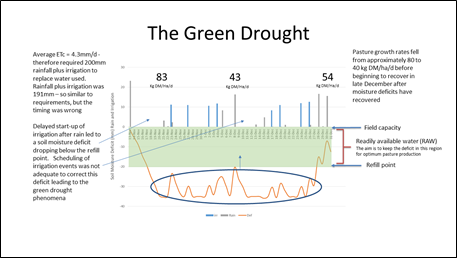
Figure 1 Starting-up irrigation too late will lead to Green Drought Source: Dr James Hills, TIA, 2018
Please watch Dr James Hills Dairy Research Foundation Video here.
At present, usual practice on many irrigating dairy farms in the Hunter region is to use visual inspection or historic management to make scheduling decisions. But in today’s variable seasonal conditions, are there better ways to apply a more informed approach? There is also a tendency to delay irrigation to postpone costs associated with water, energy and labour use or avoid maintenance outlay resulting in systems not being prepared to operate when needed or operate inefficiently.
But what is the true cost of not applying water earlier?
By not monitoring soil moisture early and throughout the season, irrigators become limited by the capacity of their systems. The water applied once start-up is delayed could possibly be ineffective if the system cannot apply irrigation at the required rate to increase, as appose to simply maintaining soil moisture, which is optimal for plant growth (called the Readily Available Water (RAW) range). Is the irrigation season ahead simply a battle to catch-up on the irrigation missed?
The most expensive water may be the water that was never applied.
How is the project assisting dairy irrigators?
The project is:
- Continuously updating a resource kit of system maintenance and efficiency check-lists for the main irrigation systems used in the region. This is improving system preparedness and increasing water and energy use efficiency across the region;
- Sign-posting dairy irrigators to other resources to improve system preparedness and increase water and energy use efficiency;
- Preparing e-learning opportunities for farmers, primarily as webinars, podcasts and short videos, to increase knowledge and understanding of the factors which influence irrigation scheduling decisions, including key terminology and interpretation of water balance information;
- Extending seasonally relevant information from irrigation sites established to demonstrate the use of two irrigation scheduling fundamentals:
- Soil moisture monitoring using sensors to indicate depth of effective water (via rainfall & irrigation), logged in real-time to a web-based platform accessible via an App.
- Use of a freely available weather based irrigation scheduling tool so that a general water balance can be determined and maintained. This is a trial App called the Scheduling Irrigation Dairy for Dairy, developed by the National Centre for Engineering in Agriculture, University of Southern Queensland & Dairy Australia; and
- Communicating project learnings and undertaking basic economic analysis.
GETTING THE FUNDAMENTALS RIGHT
This resource provides a snapshot of the project learnings to date and the benefits of getting core principles and practices of irrigation right. We have called this Irrigating more profitably: The Low Hanging Fruit as many of these are cost effective preparation and management strategies that can be implemented almost immediately. Click here to access this printable resource.
Tocal Dairy Irrigation Site
Tocal dairy is operated by NSW DPI. In early 2018 a major development of the irrigation system was undertaken resulting in the installation of three centre pivots and there are future plans to convert more of the irrigation system to overhead watering.
The dairy has partnered with the Hunter Smarter Farming: Irrigating for Profit project to assist with improved irrigation scheduling decisions and monitoring of production and profit impacts.
Hear from Tocal Dairy's managers themselves here
Read about Tocal Dairy’s plans in working with the project here.
Gloucester Irrigation Sites
The two Gloucester farms involved in the project are new to soil moisture monitoring. Their location and a timeline of their activities can be followed on Google Maps by Clicking here . EM 38 mapping and soil characterisation surveys were conducted to inform the most appropriate location of soil moisture monitoring equipment. Both sites have been installed with 80 cm EnviroPro capacitance probes with sensors located at 15cm, 40cm and 80cm depths which sample a sphere of about 100mm, however 95% of the measurement is within 50mm. Capacitence probes measure volumetric soil moisture content (mm). Each property has chosen a different telemetry systems (logging of data) to meet their particular requirements.
Tom Middlebrook- Bowman Farm, Barrington NSW
Milking herd: 450
Dairy farm area: 450 ha
Milking platform: 200 ha
Irrigated area: 100 ha
Irrigation System: 2 centre pivots, 1 lateral
Smarter Farming: 15 ha centre pivot, 5 span (270m) 1900
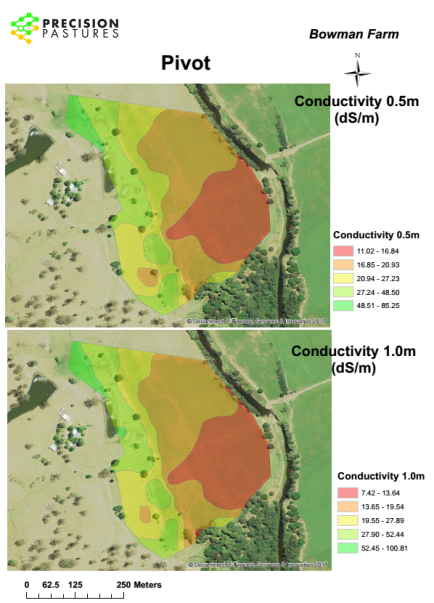
Figure 2: Bowman Farm: EM38 mapping identified variability in soil type to be considered in locating the probe.
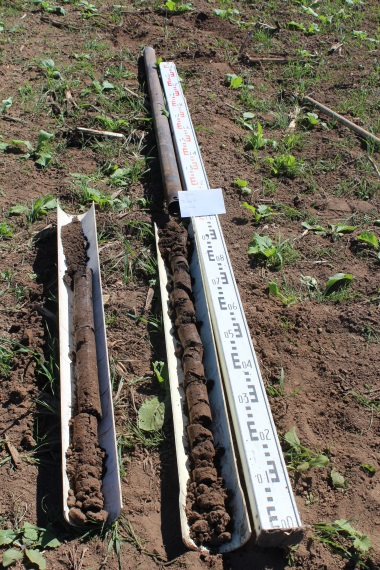
Figure 3: Soil samples taken from 1m depth cores were sampled to characterise the various soils mapped by the EM 38 survey.
Moisture monitoring equipment: Single 80cmEnviroPro capacitance probe with 3 sensor depths, Adcon NextG telemetry logger. System has capacity to accommodate multiple probes but these must be located within 60m of the logger. Automatic tipping bucket rain gauge also installed.
Hear from Tom himself by watching this short video.
Adam Forbes- Kywong Flat, Barrington, NSW

Milking herd: 700 ha
Dairy farm area: 700 ha
Milking platform: 180 ha
Irrigated area: 210 ha
Irrigation System: 2 centre pivots, bike-shift, soft-hose & hard-hose
Smarter Farming Site: 50 ha centre pivot, 7 span (450m) 1900
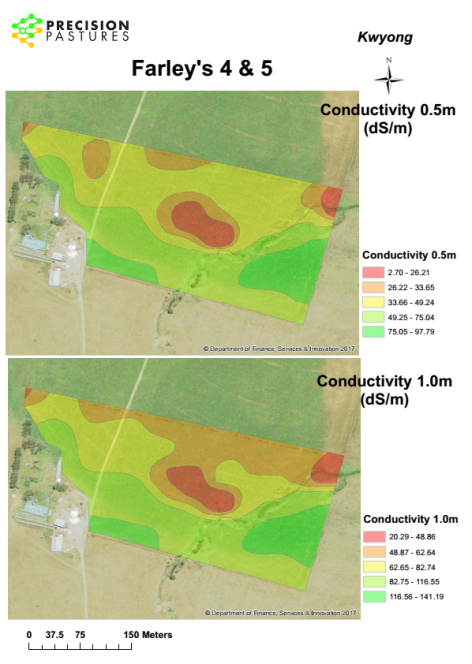
Figure 4: Kywong Flat: EM38 survey of one paddock under the pivot area identifies heavier and lighter soils.
Moisture monitoring equipment: Two 80cm EnviroPro capacitance probe with 3 sensor depths located in two separate paddocks with field telemetry loggers. The loggers feed into a LoRa Gateway base station located in a near-by office. This system allows for multiple probes to be located around the farm. Automatic tipping bucket rain gauge also installed.
Hear from Adam himself by watching this short video.
Irrigation Reports
Follow the story of the two Gloucester Smarter Farming farms as they make critical irrigation decisions to optimise the production and profitability of their study sites. Gain an insight into how they are using the available information and weighing-up the compromises.
November 2021 to January 2022 Update
Bowman Farm The Hunter Irrigating for Profit Project has just released the Bowman Farm Seasonal Irrigation Update (November 2022 -early February 2022). The late spring/ summer period has seen 629mm of rainfall so far. After planting a 90-day maize crop on the 16th of November, Tom Middlebrook says management “couldn’t be easier”. Equipment at the site was damaged during planting, leaving Tom without soil moisture, rainfall or soil temperature data for the period. He says he was fortunate this happened in a season when it was very obvious irrigation was not needed, otherwise he believes he would have struggled to make good irrigation decisions. The maize crop will be harvested around the 24th of February. Watch the video to hear from Tom himself on the decisions he made and his plans to manage increased nitrogen and seed costs this coming winter on the site!
Kywong Flat
The Hunter Irrigating for Profit Project has just released the Kywong Seasonal Irrigation Update (November 2021-early February 2022). “It’s really been quite challenging wet conditions, whether that has been managing grazing, making silage or just trying to get the cows to the paddock with the Barrington River coming through the farm,” provides Adam. Whilst there were actually two periods when soil moisture dropped below RAW, irrigation was not applied as Adam’s forecast data gave him confidence that rainfall would imminently refill the profile in coming days. “You need to use all the data in front of you to make those decisions,” he says.
Watch the video to hear from Adam himself on the decisions he made across both sites when faced with the need to irrigate this season!
The Hunter Irrigating for Profit Project has just released the Seasonal Irrigation Update for its two sites in Gloucester, NSW. Both Tom Middlebrook and Adam Forbes have experienced very wet conditions with over 620mm of rainfall recorded during the period. The report demonstrates the decisions that were made, especially at Kywong Flat, not to irrigate when soil moisture levels dropped below Readily Available Water (RAW), relying upon forecasted rainfall to eventuate. Delaying irrigation avoided waterlogging conditions at Kywong Flat, especially on paddock F3. The Bowman Farm maize crop is considered a “bumper” result by Tom.
During the period both farms had difficulties with their 3-year-old soil moisture monitoring equipment, a reminder that:
- The technology needs to be actively maintained; and
- when it comes to making purchase decisions, most often you get what you pay for!
“It’s a reminder that these systems are not set and forget,” says Adam. “You really need to be monitoring them and make sure that what you are seeing is ground-truthed.” Read the short report to keep up to date and considerations for your own irrigation scenarios!
August to November 2021 Update
Bowman Farm The Hunter Irrigating for Profit Project has just released the Bowman Farm Seasonal Irrigation Update (August-early November 2021). The winter period was a true irrigation season for Tom Middlebrook. Low rainfall in August and early September saw applications of irrigation slow soil moisture decline, but not stop the decline. Tom was forced to make decisions on allocating water across the milking platform, potentially effecting optimal growth of the Italian rye/ barley/ brassica mixed pasture. Rainfall events in September and October increased soil moisture to finish the pasture well. The site has been prepared for the imminent sowing of the summer maize crop. Watch the video to hear from Tom himself on the decisions he made and how he is preparing for the summer maize!
The Hunter Irrigating for Profit Project has just released the Seasonal Irrigation Update for its two sites in Gloucester, NSW. Both Tom Middlebrook and Adam Forbes have managed irrigation through a very dry winter season, with rainfall not eventuating until the second week in September. The report demonstrates the site specific decisions that have to be made in this situation dependent upon the pasture mix, soil type and water availability. With a wetter summer predicted, the report also outlines the plans for the coming months, including improved use of soil moisture graphs to closely monitor conditions at varying soil depths. Both Tom and Adam need to monitor, and adjust irrigation frequency and rates accordingly, to manage developing roots as well as pasture mixes with both shallow and deep rooted species. Read the short report to keep up to date and considerations for your own irrigation scenarios!
May to July 2021 Update
Bowman Farm The Hunter Irrigating for Profit Project has just released the Bowman Farm Seasonal Irrigation Update (May-July 2021). Bouncing-back from the impact of the extreme rainfall event of March, Tom Middlebrook has managed to improve production results of the slow starting Italian rye/ barley/ brassica mixed pasture. May to mid-June delivered ideal moisture levels, with small amounts of rainfall over the duration providing adequate moisture without saturation. The critical period for the farm has come in July with very limited rainfall and very little predicted. Tom has started irrigating and using nitrogen strategically to drive growth. Initial application saw little effect- so how does he plan to respond? Watch the video to hear from Tom himself on the decisions he now needs to make and how he is monitoring the effectiveness of these decisions!
Kywong Flat The Hunter Irrigating for Profit Project has just released the Kywong Flat Seasonal Irrigation Update (May-July 2021). With “ideal” conditions prevailing throughout May to mid-June, Adam Forbes is the first to admit that he had become a little complacent about monitoring his soil moisture and therefore his telemetry base station lay idle after power was lost to the shed during the rainfall event of March. With conditions obviously changing, strong winds, dry days and increased ETo, Adam decided he needed to know what was happening beneath the ground. It was just in time when his telemetry commenced to collect data from the soil moisture probes again on the 23rd of June- things were drying and moisture across both sites was trending downwards! Initial irrigation impacts were short-lived and the farm has truly entered a mid-winter irrigation season! Watch the video to hear from Tom himself on the decisions he now needs to make and how he is monitoring the effectiveness of these decisions!
February to April 2021 Irrigation report
Bowman Farm: The effects of extreme rainfall events have resulted in disappointing establishment of the rye/ barley/ brassica mixed pasture that was aerial broadcast, after 450mm across 6-days, in March. Soil moisture monitoring demonstrates that after extreme saturation the top 40cm of the soil profile, where the young roots are developing, has actually dried swiftly and is heavily compacted. Whilst the soil moisture graph shows that irrigation is not needed, the stacked graph is highlighting the need to irrigate carefully to provide moisture to where it is needed at this time. With flooding causing damage to the pivot’s motor, Tom is relying upon the 30mm forecast by his SWAN Systems notification to provide this moisture. Slow growth means that the paddock is still at least 14 days away from first grazing and Tom has attempted to boost development with additional nitrogen that would have been lost from the system through run-off and leaching. Watch the video to hear from Tom himself on the impact of high rainfall and the decisions made during this stressful period!
Kywong Flat: The effectiveness of extreme rainfall recovery at Kywong Flat reflects the different pasture establishment stages and soil types of the sites, prior to the March 450mm in 6-days event. On F6, a combination of the paddock being sown to Prairie Grass in early March, and a good free draining soil, has delivered good recovery and grazing is imminent. F3 had not undergone winter sowing prior to the rainfall event, leaving poor quality silage to be cut from the site followed by Italian Ryegrass sowing in early April. Establishment has been slow. Weather events have affected access to soil moisture technology data with power cut to the base station mid-March. Adam is currently relying upon visual decisions once again and realises he needs to reinstate the pump to the river and consider starting to irrigate.
Watch the video to hear from Adam himself!
November 2020 - January 2021 Irrigation report
Bowman Farm - The sorghum crop was watered-in during early November. Although a dry-spell mid-November to mid-December saw soil moisture decline, the low water use of the developing plant, together with the RAW “bucket” already at full point, this had little impact on overall soil moisture. See how Tom then used forecast weather information to manage the forage crop during a December to January period that saw over 500mm of rainfall!
Watch this video from Bowman Farm to hear from Tom himself, interviewed by Peter Beale (Hunter LLS Senior Land Services Officer, Agronomy)!
Kywong Flat - Adam strategically irrigated the different soil/ plant types, under the single pivot, of his monitored paddocks of F6 and F3 to maintain his RAW “bucket” during the mid-November to mid-December dry-spell. With good soil moisture and mid-range evapotranspiration (ETo) growth rates were ideal. Using weather forecasts to make informed decisions, learn how Adam allowed soil moisture to decrease before predicted rainfall events lifted soil moisture beyond full-point.
Watch this video from Kywong Flat to hear from Adam himself, interviewed by Peter Beale (Hunter LLS Senior Land Services Officer, Agronomy)!
July - October 2020 Irrigation Report
Bowman Farm - The winter pasture of the study site finished strongly after strategic irrigation was used during a dry-spell following good rainfall. After three years of use, Tom Middlebrook reports that he has certainly changed his irrigation practices, making sure he responds to declining soil moisture and forecasted rising evapotranspiration (ETo). Soil moisture monitoring data shows that levels were maintained in the RAW but Tom certainly drew upon his soil water “bucket” to do this. The season will likely need increased irrigation rates as the newly sown Sorghum forage crop develops. Watch the video to hear from Tom himself!
Kywong Flat - In the words of Adam Forbes, spring growth has been “phenomenal” because irrigation has been used strategically between rainfall events to keep soil moisture levels up. Adam says he would not have irrigated if the soil moisture monitors had not been in place, subsequently he has unprecedented yield of an estimated 100-120 kgDM/ha/day from his Italian ryegrass/ white clover pasture on paddock F3. A seven week turn-around from sowing to first grazing on F6 he also believes is due to irrigating at the right time, predominantly to keep the paddock from getting too saturated. Watch the video to hear from Adam himself!
April - June 2020 Irrigation Report
The importance of closely monitoring soil moisture over the autumn period to inform irrigation start-up and scheduling decisions is highlighted in this period’s report from Bowman Farm and Kywong Flat, Gloucester. Although irrigation start-up was a little delayed, both Tom Middlebrook and Adam Forbes managed to keep soil moisture levels within the optimal zone for active plant growth and have reaped the rewards by maintaining a good rotation over an otherwise dry autumn.
Watch this video from Tom Middlebrook on his irrigation management to combat a dry autumn period.
Watch this video for a quick summary of the dry conditions and irrigation management at Kywong Flat over autumn.
February 2020 Drought Recovery
Adam Forbes and Tom Middlebrook meet with the project to talk about the impacts of the drought and their plans for recovery after a number of good rainfall events. Watch this video
February - March 2020 Irrigation Report
Click here for the PDF report.
Watch this video from Adam Forbes about conditions at Kywong Flat.
Watch this video from Tom Middlebrook about his irrigation decisions during this period.
October 2019-January 2020 Irrigation Report
Watch this video from Adam Forbes about conditions at Kywong Flat.
Watch this video from Tom Middlebrook talking about his irrigation decisions during this period.
July – September 2019 Irrigation Report
Hear from Adam Forbes about his irrigation decisions this period at Kywong Flat
April – June 2019 Irrigation Report
Listen to a podcast of Tom Middlebrook talking about his irrigation decisions at Bowman Farm April-June 2019.
Listen to a podcast of Adam Forbes talking about his irrigation decisions at Kywong Flat April-June 2019.
Both podcasts also provide a short discussion on the results and recommendations of a recent irrigation system evaluation.
February - March Irrigation 2019 Report
Summer Season Irrigation Report (November 2018- January 2019)
Hear from Tom Middlebrook on his decisions at Bowman Farm: Click here
Hear from Adam Forbes on his decisions at Kywong Flat: Click here
Smarter Farming Resources
The Hunter Smarter Farming Project produces local resources to assist Hunter dairy irrigators to improve irrigation start-up and gate “Green Drought” production losses. These resources increase knowledge, understanding and preparedness to forward plan irrigation scheduling (especially timing) which will maximise yield potential under irrigation.
Videos & podcasts
Measure to manage- Using the Readily Available Water approach
How can you determine what water is needed for the soil and plant type under irrigation? The answer is Readily Available Water (RAW)! Project Manager, Marguerite White, explains why RAW is important and how to irrigate to ensure plant growth can be optimised by monitoring soil moisture and maintaining it within the RAW. She visits Tocal Dairy to chat to farm manager, Matt Brett on how he is using RAW and soil moisture monitoring to improve his irrigation management.
Irrigation System Evaluations- Get your system operating efficiency!
Avoiding “The Green Drought”- a 101 video for all irrigators!
Tasmanian Institute of Agriculture (TIA) dairy researchers, Dr James Hills & Dr Mark Freeman, explain the Green Drought phenomenon and provide practical information to avoid lost production by not commencing irrigation on time. This is a 30 minute presentation which will be sure to change your approach to timing irrigation start-up.
Click here to avoid The Green Drought
Preparing your irrigation system to make sure you are ready to start!
A quick list for preparing your system.
Click here for a quick overhead irrigation check
Pumping Irrigation Water- efficient operation pays!
A Tamworth dairy farm was assisted by an external irrigation consultant to identify ways to more efficiently pump water to reduce costs.
Click here to reduce costs associated with moving water
Soil Moisture Monitoring
The Hunter Smarter Farming Project uses soil moisture monitoring at the Gloucester and Hunter Valley demonstration farms to better gauge when irrigation should commence. In this video, Brian Thomson of Porosity Agricultural Services explains why soil moisture monitoring is important in making irrigation scheduling decisions and provides a good insight into choosing and installing soil moisture monitoring probes.
Click here to learn about Soil Moisture Monitoring
Management and System Checklists
Hunter Smarter Farming Checklist Bike Shift
Hunter Smarter Farming Checklist CPLM
Hunter Smarter Farming Checklist K-Line
Hunter Smarter Farming Checklist Travellers
Hunter Smarter Farming Irrigation Development Decisions
Hunter Smarter Farming Soil Moisture Monitoring Check
Listen to a 15 minute podcast interview conducted by Hunter Smarter Farming Project Manager, Marguerite White, with Irrigation System Consultant, Peter Smith (Sapphire Irrigation Consulting). Peter outlines the main priorities when it comes to having irrigation systems ready for start-up and operating efficiently during the irrigation season. After listening, download the check-lists relevant to your irrigation system above- and get started, smarter!
Project Baseline Reports
SIP Soils Report 'Kywong Flat'
SIP Soils Report 'Bowman Farm'
Useful sign-posts to external resources
Dairy Australia Smarter Irrigation for Profit 2 Website- Click here
The SIP2 project is a collaboration between the dairy, cotton, sugar, rice and grain industries, building upon the outcomes of the first phase of the project (SIP1), to improve productivity and profitability from irrigation across these sectors. From 2019-2022 Dairy Australia’s sub-project, SIP2: What’s my yield gap? Maximising Water Productivity, is conducting 10 Dairy Optimisation Sites across Australia to measure the yield, energy and water outcomes of adopting the core principles emanating from SIP1 and applying new technologies. NSW has 3 of these sites located in Bega, our own Tocal Dairy, and the Northern Rivers region.
DairyNZ Irrigation Website- Click here
Practical guides, checklists and tips for maintaining and operating your irrigation system as well basic soil science and scheduling concepts explained simply. A good site to get you started, especially after watching the The Green Drought presentation above.
Irrigation New Zealand Practical Resources - Click here
This site provides essential foundational irrigation information- from the need to know soil science basics to detailed considerations when exploring advanced technologies in monitoring and application equipment.
Need to know more about soil moisture monitoring options?
Go straight to this Irrigation New Zealand publication- Click here for SMM Guide (Book 11)
Dairy Australia has a new short publication on options- Click here for SMM Information Sheet
Contact
To find out anything further on the project, please contact Marguerite White, Project Manager, ICD Project Services at mwhite@icdprojectservices.com.au or phone: 0447 500 415.
